Towards live and attractive Solkan historical core
Edited on
12 August 2022By Nataša Kolenc and Aleksandra Torbica, Municipality of Nova Gorica, Slovenia
"Every good story comes to an end. URBACT Thriving streets project WOW Mobilet Solkan finished its tour yesterday under the mighty linden trees in Plenčič Square in Solkan. We want to thank many guests for visiting us. We made new acquaintances, strengthened friendships and made many new plans for the future. We would like to say a big THANK YOU from the ❤️ to all of you who supported us in this project. Thank you to all the neighbours for your patience. One big THANK YOU also to the performers and Ma Vita who made the evenings so much more enjoyable and gave good energy to everyone."

The quotation at the beginning was published in October 2021 by the caterer Matej Vodan (CULNART), one of Mobilet kiosk tenants, who was part of the URBACT Thriving Streets project's Small scale action in Solkan. The post shares the feelings many people had regarding the changes that the project brought to Solkan historical core - the oldest part of Nova Gorica urban area with recognizable identity and centuries long history as a local centre.
The whole URBACT Thriving Streets project story started years before – with the decision of Municipality of Nova Gorica in 2019 to focus its project activities on Solkan historical core. Solkan’s or Castrum Silicanum written history started in 1001, more than thousand years ago. It is mentioned in a document including the statement “…MEDIETATEM UNIUS CASTELLI QUOD DICITUR SILIGANUM ET MEDIETATEM UNIUS VILLE QUE SCLAVORUM LINGUA VOCATUR GORIZA”, in translation “…the half of the castle called Siliganum and the half of the village which in the language of the Slavs is called Goriza…” (Gorica in Slovenian).
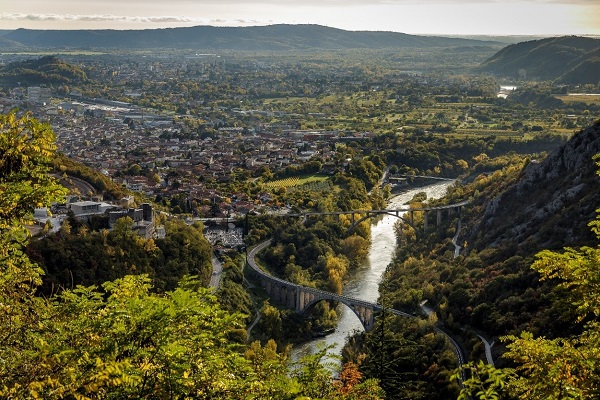
The sentence is not only important for Solkan, but it demonstrate the presence of Slovenian (Slavic) language and people in the area for more than 1000 years. Solkan’s recorded history is even longer and very interesting. It goes back for at least 3000 years to prehistoric times. The place is a living monument of different eras and historical events that have shaped this part of Europe and that have affected the lives of people to these days.
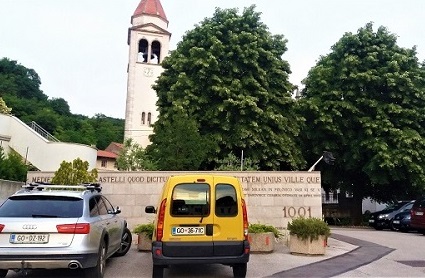
Despite the indisputable importance of Solkan and its centuries-old role as a lively local centre, the place is becoming more and more neglected. The decline in the last decades is caused, among other, by the lack of appropriate spatial interventions and management, loss of public offices and other public functions, inappropriate handling of the growing transit traffic through the area, reduction of community spaces (indoor and outdoor), inadequate buildings renovations, the increasing number of parked cars on all public surfaces and (also consequently) the relocation of commercial activities from the city streets to the suburban shopping centres. These facts eventually changed Solkan, particularly its historic core, from a pleasant and lively place to the less attractive and in some places neglected environment. The present situation offers poor support to the quality of life of its inhabitants, attractiveness of commercial offer and interest of visitors to discover the interesting stories and places Solkan has to offer.
The Municipality of Nova Gorica and different local stakeholders recognised the negative trend and the damage done to Solkan’s local community. To understand and consider different points of view of different stakeholders, series of workshops, several discussions and checks have been organized since 2019. The result was the newly defined vision for Solkan’s future development which says: “The historic core of Solkan is (again) a lively town with people, bars and shops, pleasant for its inhabitants, attractive for tourists and safe (traffic) to the point that an 8 year-old child can move around independently, walking or cycling without the company of an adult person.”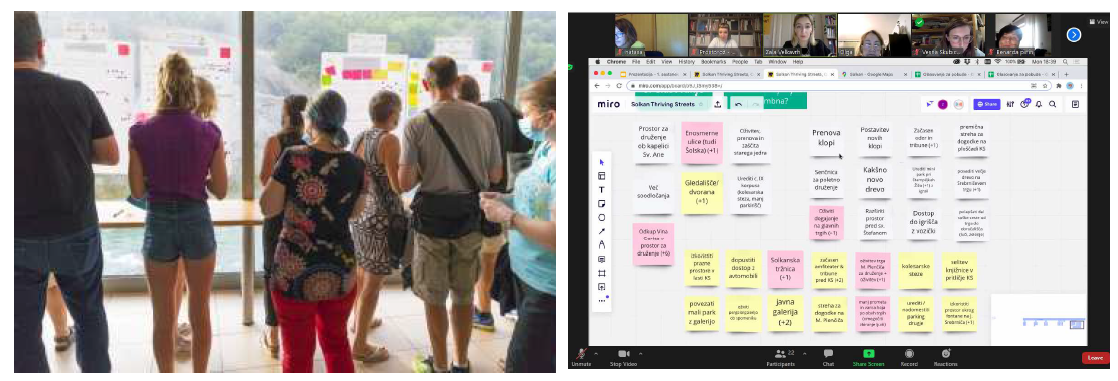
That vision became the backbone of URBACT Thriving Streets project Small-scale action (SSA), shaped and brought to life in Summer 2021. It was designed as a temporary rearrangement of Solkan’s oldest square (Trg Marka Antona Plenčiča) and surrounding streets. The new arrangement gave more space to pedestrians and cyclists by closing small parts of the streets and square for motor traffic and by relocating part of the parking spaces to a less exposed location nearby.
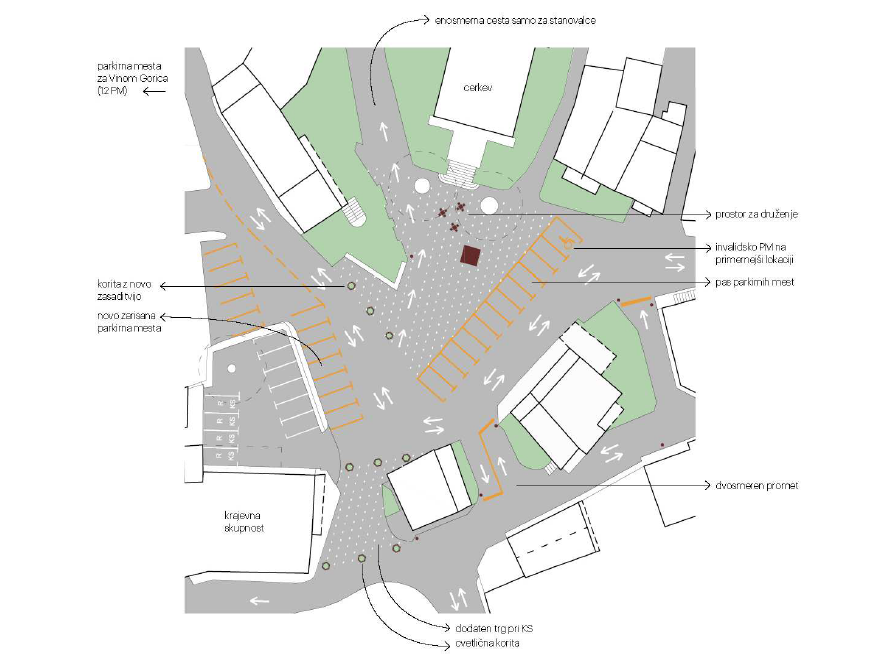
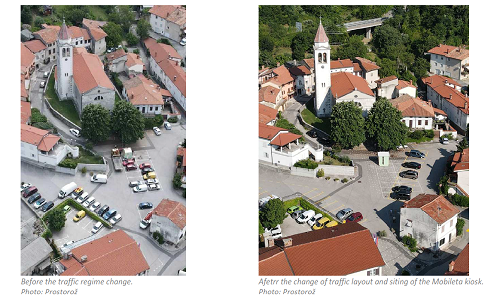
The central position of the new arrangement was given to the wooden kiosk named Mobilet - a tribute to the Solkan's centuries-old carpentry tradition. The green kiosk mentioned at the beginning of this story offered a temporary “home” to several local provides and their cultural, social, gastronomical or other public programmes. They proved that Solkan’s historical core, with the church of St. Stephen and two mighty linden trees in the heart of the settlement, can be transformed in a shape closer to the vision determined by the local stakeholders in 2019.
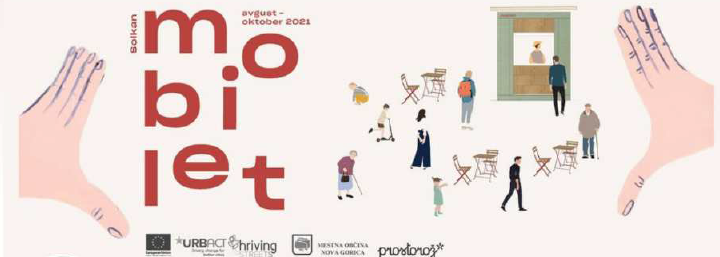
The new arrangement and new programmes were intended primarily to the local inhabitants and providers from Solkan and wider Nova Gorica/Gorizia urban area. They were also the ones who were asked for the opinion regarding URBACT Thriving Streets project Small-scale action in Solkan at the end of the testing period. Considering all aspects, general opinion of the different people and institutions supported the further development and improvement of Solkan historical core area.
With one important exception: residents of the Marko Plenčič square and surrounding streets. They were used to use the (common) public space in their way for decades, mostly to drive and parking their cars as close to the house doors as possible. Rejection of local residents, together with the lack of political will to implement the necessary, but sometimes unpleasant changes (of one shape or another), caused further improvement activities to be stopped. In that way the testing arrangement, unfortunately, was not followed by widely discussed and improved arrangement of Solkan historical core. The square traffic and general arrangement was returned to exactly the same shape as before the testing period.
Despite this, URBACT Thriving Streets Small-scale action gave a precious learning lesson. It pointed out the importance of abandoned complex of former Vino Gorica, the questions about locating services as Home care centre (Pomoč na domu), the importance of managing the diversity of opinions and conflicts among different stakeholders, understanding of scale of (dis)respect of (common) public space and other aspects, which have to be considered while planning any changes in the future.
All findings and conclusions were incorporated in URBACT Thriving Streets Integrated Action Plan for Solkan titled “Toward live and attractive Solkan's historical core”.
The written Integrated Action Plan represents the useful basis for more effective management of the area. It will be used in the future to shape better public space and better use that Solkan historical core and the local community deserve.
***
Picture 1: Solkan's historical centre during the URBACT Thriving streets Small Scale Action rearrangement in summer 2021. Photo Mateja Pelikan.
Picture 2: Cross-border urban area of Nova Gorica, Gorizia/Gorica on Italian side of the border and Šempeter-Vrtojba, with Solkan in front of the picture, showing also Solkan Bridge crossing Soča/Isonzo river. Photo: Klub Zagon.
Picture 3: Part of Solcan historical core in June 2021, prior to URBACT Thriving Streets project temporary interventions - with church, two mighty linden trees and a monument (in front, partly covered by cars and vegetation) dedicated to 1000th anniversary of Solkan’s first mentioning in written documents. Photo: Nataša Kolenc.
Picture 4 and 5: Workshop with different local stakeholders and UGL members in Solkan 2019 (left) and on-line workshop with institutions and economic operators during COVID-19 restrictions in 2021. Photo: Aleksandra Torbica.
Picture 6: The plan of Solkan historical core rearrangement during URBACT Thriving Streets project Small-Scale Action in 2021. Author: Prostorož.
Picture 7 and 8: Solkan historical core before and after rearrangement during URBACT Thriving Streets project Small Scale Action in 2021. Photo: Prostorož.
Picture 9: Kiosk Mobilet's programme FB page, https://www.facebook.com/mobilet.solkan/
Submitted by Francesca Blamonti on
